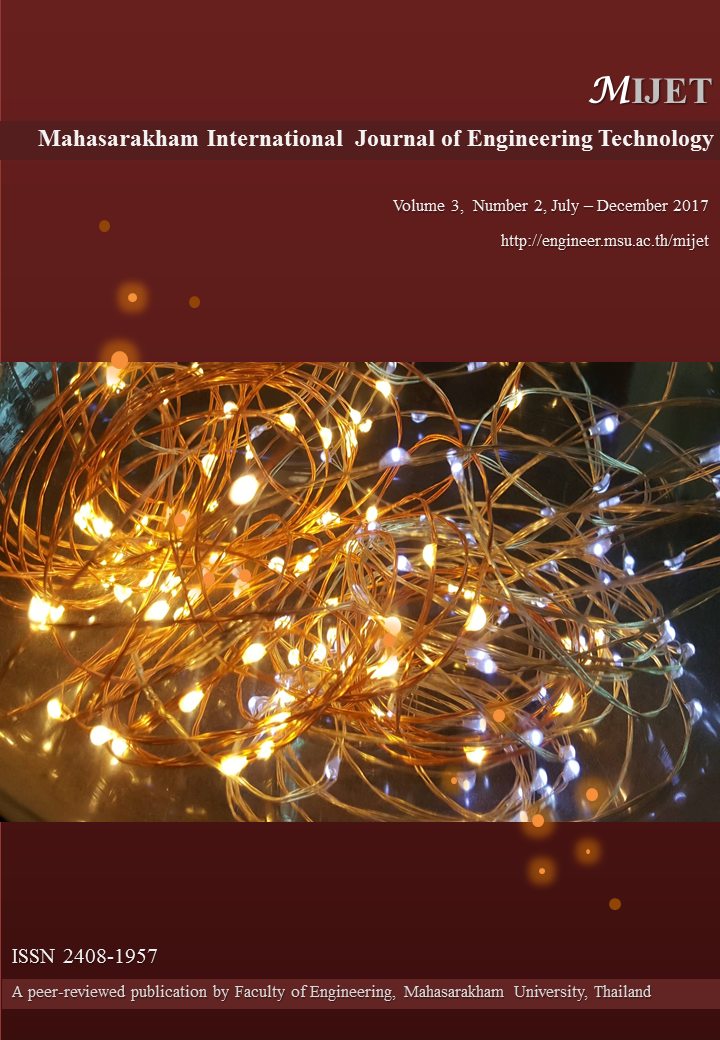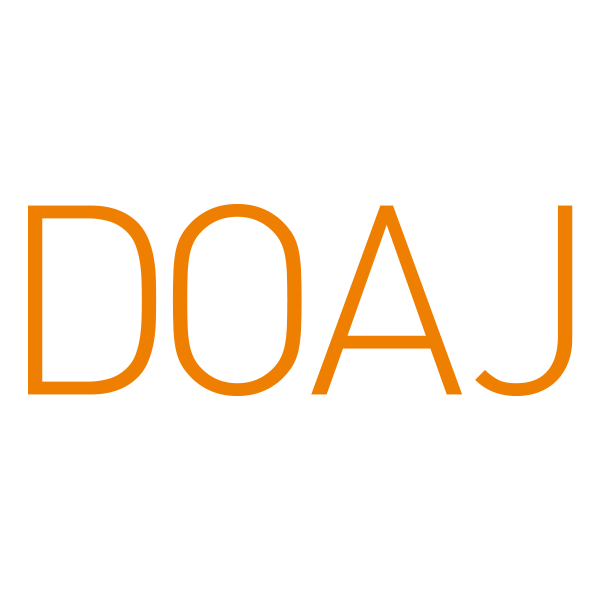An Evaluation of EO-1 Hyperion Data for Estimating Age of Rubber Plantation
doi: 10.14456/mijet.2017.8
Keywords:
Hyperspectral remote sensing, Age of rubber plantation, Vegetation indices.Abstract
In this paper, the ability to estimate the rubber plantation’s age of hyperspectral remote sensing with Hyperion satellite is proposed. Age of rubber plantation was estimated by four popular vegetation indices (i.e., Simple Ratio index, Modified Simple Ratio Index, Normalized Difference Vegetation Index, and Modified Soil Adjusted Vegetation Index). Despite additional fine-tuning needing to be done on the statistical model parameters, the proposed models reveal significantly high statistical correlations. The best-fitted model was determined to be the MSAVI705 model (R2 = 0.624), which possesses the lowest RMSE values (=2.625). It is anticipated that the methodology presented in this study can be used as a guideline for estimating the rubber plantation’s age in other areas.
References
[2] SURATMAN, M. N., BULL G. Q., LECKIE D. G., LEMAY V., AND MARSHALL P. L. Modelling attributes of Rubberwood (Hevea brasiliensis) stands using spectral radiance recorded by Landsat Thematic Mapper in Malaysia. Geoscience and Remote Sensing Symposium, 2002. IGARSS’02. 2002 IEEE International, vol. 4, pp. 2087–2090.
[3] GUISHUI L. J. L. W. X. AND FEN A. Status of rubber-wood processing and utilization in Hainan Province. Chin. J. Trop. Agric., 2010, vol. 3, p. 67–70.
[4] WULDER, M.A., SKAKUN, R.S., KURZ, W.A., WHITE, J.C. Estimating time since forest harvest using segmented Landsat ETM+ imagery. Remote Sens. Environ., 2004, 93,179–187.
[5] ZHANG, Q., PAVLIC, G., CHEN, W., LATIFOVIC, R., FRASER, R., CIHLAR, J. Deriving stand age distribution in boreal forests using SPOT VEGETATION and NOAA AVHRR imagery. Remote Sens. Environ., 2004, 91, 405–418.
[6] SIVANPILLAI, R., SMITH, C.T., SRINIVASAN, R., MESSINA, M.G., WU, X.B. Estimation of managed loblolly pine stand age and density with Landsat ETM+ data. Forest Ecol. Manage., 2006, 223, 247–254.
[7] WANG, S., ZHOU, L., CHEN, J., JU, W., FENG, X., WU, W. Relationships between net primary productivity and stand age for several forest types and their influence on China’s carbon balance. J. Environ. Manage., 2011, 92, 1651–1662.
[8] Li Z. and Fox J. M. Rubber tree distribution mapping in Northeast Thailand,” Int. J. Geosci., 2011, vol. 2, no. 4.
[9] CHEN, B., CAO, J., WANG, J., WU, Z., TAO, Z., CHEN, J., ... & XIE, G. Estimation of rubber stand age in typhoon and chilling injury afflicted area with Landsat TM data: A case study in Hainan Island, China. Forest ecology and management, 2012, 274, 222-230.
[10] PUTKLANG W., MANEECHOT S., AND MONGKOLSAWAT C., ASSESSING THAICHOTE. satellite data in support of mapping rubber tree plantation in Northeast Thailand. the 33rd Asian Conference on Remote Sensing 2012, ACRS 2012, vol. 3, pp. 2269–2275.
[11] SIVANPILLAI R., SMITH C. T., SRINIVASAN R., MESSINA M. G., AND WU X. B. Estimation of managed loblolly pine stand age and density with Landsat ETM+ data. For. Ecol. Manag.,2006, vol. 223, no. 1, pp. 247–254.
[12] KAUTH R. J. AND THOMAS G. S. The tasselled cap–a graphic description of the spectral-temporal development of agricultural crops as seen by Landsat. LARS Symposia, 1976, p. 159.
[13] ZHANG, Q., PAVLIC, G., CHEN, W., LATIFOVIC, R., FRASER, R., & CIHLAR, J. Deriving stand age distribution in boreal forests using SPOT VEGETATION and NOAA AVHRR imagery. Remote Sensing of Environment, 2004, 91.3: 405-418.
[14] SIVANPILLAI, R., SMITH, C. T., SRINIVASAN, R., MESSINA, M. G., & WU, X. B. Estimation of managed loblolly pine stand age and density with Landsat ETM+ data. Forest Ecology and Management, 2006, 223(1), 247-254.
[15] RACINE, E. B., COOPS, N. C., ST-ONGE, B., & BÉGIN, J. Estimating forest stand age from LiDAR-derived predictors and nearest neighbor imputation. Forest Science, 2014, 60(1), 128-136.
[16] WULDER, M. A., SKAKUN, R. S., KURZ, W. A., & WHITE, J. C. Estimating time since forest harvest using segmented Landsat ETM+ imagery. Remote Sensing of Environment, 2004, 93(1), 179-187.
[17] PU, R., GONG, P., AND YU, Q. Comparative analysis of EO-1 ALI and Hyperion, and Landsat ETM+ data for mapping forest crown closure and leaf area index. Sensors, 2008, 8(6), 3744-3766.
[18] HEISKANEN, J., RAUTIAINEN, M., STENBERG, P., MÕTTUS, M., AND VESANTO, V.-H. Sensitivity of narrowband vegetation indices to boreal forest LAI, reflectance seasonality and species composition. ISPRS Journal of Photogrammetry and Remote Sensing, 2013, 78, 1-14.
[19] BECK, R. EO-1 user guide, version 2.3, Satellite Systems Branch, USGS Earth Resources Observation Systems Data Center (EDC)., 2003.
[20] DATT, B., MCVICAR, T. R., VAN NIEL, T. G., JUPP, D. L., AND PEARLMAN, J. S. Preprocessing EO-1 Hyperion hyperspectral data to support the application of agricultural indexes. IEEE Transactions on Geoscience and Remote Sensing, 2003, 41(6), 1246-1259.
[21] THENKABAIL, P. S., MARIOTTO, I., GUMMA, M. K., MIDDLETON, E. M., LANDIS, D. R., AND HUEMMRICH, K. F. Selection of Hyperspectral Narrowbands (HNBs) and
MAHASARAKHAM INTERNATIONAL JOURNAL OF ENGINEERING TECHNOLOGY, VOL. 3, NO. 2, JULY-DECEMBER 2017 9
Composition of Hyperspectral Twoband Vegetation Indices (HVIs) for biophysical characterization and discrimination of crop types using field reflectance and hyperion/EO-1 data. IEEE Journal of Selected Topics in Applied Earth Observations and Remote Sensing, 2013, 6(2), 427-439.
[22] KAPLAN, E. D., AND HEGARTY, C. J. Understanding GPS: principles and applications, 2005, (Artech House Publishers, 200-211).
[23] GITELSON, A. A. AND MERZLYAK, M. N. Signature analysis of leaf reflectance spectra: algorithm development for remote sensing. Journal of plant physiology, 1996, 148(3), 493–500.
[24] ROUSE, J. W., A, T., CENTER, M. U. R. S., HAAS, R. H., CENTER, G. S. F., AND SCHELL, J. A. Monitoring the Vernal Advancement and Retrogradation (greenwave Effect) of Natural Vegetation, Texas A & M University, Remote Sensing Center, 1974.
[25] SIMS, D.A., AND GAMOM, J.A. Relationships between leaf pigment content and spectral reflectance across a wide range of species, leaf structures and developmental stages. Remote Sensing of Environment, 2002, 81, 337–354.
[26] HUETE, A. R. A soil-adjusted vegetation index (SAVI). Remote sensing of environment, 1988, 25(3), 295–309.
[27] SURATMAN, M.N. Applicability of Landsat TM Data for Inventorying and Monitoring of Rubber (Hevea brasiliensis) Plantations in Selangor, Malaysia: Linkages to Policies. The University of British Columbia, Vancouver, Canada, 2003, p.226.
[28] KOEDSIN, W., & HUETE, A. Mapping Rubber Tree Stand Age using Pléiades Satellite Imagery: A Case Study in Talang District, Phuket, Thailand. Engineering Journal, 2015, 19(4), 45-56.
[29] WU, C., HAN, X., NIU, Z., AND DONG, J. An evaluation of EO-1 hyperspectral Hyperion data for chlorophyll content and leaf area index estimation. International Journal of Remote Sensing, 2010, 31(4), 1079-1086.
[30] VYAS, D., CHRISTIAN, B., AND KRISHNAYYA, N. Canopy level estimations of chlorophyll and LAI for two tropical species (teak and bamboo) from Hyperion (EO1) data. International Journal of Remote Sensing, 2013, 34(5), 1676-1690.
Downloads
Published
How to Cite
Issue
Section
License
Copyright (c) 2017 Mahasarakham International Journal of Engineering Technology

This work is licensed under a Creative Commons Attribution-NonCommercial-NoDerivatives 4.0 International License.





